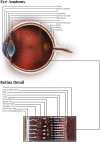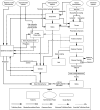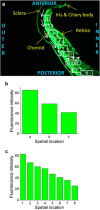Distribution of polymeric nanoparticles in the eye: implications in ocular disease therapy
- PMID: 33413421
- PMCID: PMC7789499
- DOI: 10.1186/s12951-020-00745-9
Distribution of polymeric nanoparticles in the eye: implications in ocular disease therapy
Abstract
Advantages of polymeric nanoparticles as drug delivery systems include controlled release, enhanced drug stability and bioavailability, and specific tissue targeting. Nanoparticle properties such as hydrophobicity, size, and charge, mucoadhesion, and surface ligands, as well as administration route and suspension media affect their ability to overcome ocular barriers and distribute in the eye, and must be carefully designed for specific target tissues and ocular diseases. This review seeks to discuss the available literature on the biodistribution of polymeric nanoparticles and discuss the effects of nanoparticle composition and administration method on their ocular penetration, distribution, elimination, toxicity, and efficacy, with potential impact on clinical applications.
Keywords: Drug delivery system; Ocular biodistribution; Ocular drug delivery; Polymeric nanoparticle.
Conflict of interest statement
The authors declare that they have no competing interests.
Figures




Similar articles
-
Polymeric micelles for ocular drug delivery: From structural frameworks to recent preclinical studies.J Control Release. 2017 Feb 28;248:96-116. doi: 10.1016/j.jconrel.2017.01.012. Epub 2017 Jan 11. J Control Release. 2017. PMID: 28087407 Free PMC article. Review.
-
Fostering the unleashing potential of nanocarriers-mediated delivery of ocular therapeutics.Int J Pharm. 2024 Jun 10;658:124192. doi: 10.1016/j.ijpharm.2024.124192. Epub 2024 May 3. Int J Pharm. 2024. PMID: 38703931 Review.
-
Nanoplatforms for Delivery of siRNA to the Eye.Curr Pharm Des. 2015;21(31):4587-93. doi: 10.2174/138161282131151013191051. Curr Pharm Des. 2015. PMID: 26486145 Review.
-
Stimuli-Responsive Polymeric Systems for Controlled Protein and Peptide Delivery: Future Implications for Ocular Delivery.Molecules. 2016 Jul 30;21(8):1002. doi: 10.3390/molecules21081002. Molecules. 2016. PMID: 27483234 Free PMC article. Review.
-
A review of nanocarrier-mediated drug delivery systems for posterior segment eye disease: challenges analysis and recent advances.J Drug Target. 2021 Aug;29(7):687-702. doi: 10.1080/1061186X.2021.1878366. Epub 2021 Feb 1. J Drug Target. 2021. PMID: 33474998 Review.
Cited by
-
Novel Eye Drop Delivery Systems: Advance on Formulation Design Strategies Targeting Anterior and Posterior Segments of the Eye.Pharmaceutics. 2022 May 27;14(6):1150. doi: 10.3390/pharmaceutics14061150. Pharmaceutics. 2022. PMID: 35745723 Free PMC article. Review.
-
Soluplus® polymeric nanomicelles improve solubility of BCS-class II drugs.Drug Deliv Transl Res. 2022 Aug;12(8):1991-2006. doi: 10.1007/s13346-022-01182-x. Epub 2022 May 23. Drug Deliv Transl Res. 2022. PMID: 35604634 Free PMC article.
-
Utilization of Nanoparticles for Treating Age-Related Macular Degeneration.Pharmaceuticals (Basel). 2025 Jan 25;18(2):162. doi: 10.3390/ph18020162. Pharmaceuticals (Basel). 2025. PMID: 40005976 Free PMC article. Review.
-
Intraocular injectable hydrogels for the delivery of cells and nanoparticles.Mater Today Bio. 2025 Apr 12;32:101767. doi: 10.1016/j.mtbio.2025.101767. eCollection 2025 Jun. Mater Today Bio. 2025. PMID: 40290894 Free PMC article. Review.
-
Recent Advances in Ocular Drug Delivery: Insights into Lyotropic Liquid Crystals.Pharmaceuticals (Basel). 2024 Oct 2;17(10):1315. doi: 10.3390/ph17101315. Pharmaceuticals (Basel). 2024. PMID: 39458956 Free PMC article. Review.
References
-
- Bourne RRA, Flaxman SR, Braithwaite T, Cicinelli MV, Das A, Jonas JB, et al. Magnitude, temporal trends, and projections of the global prevalence of blindness and distance and near vision impairment: a systematic review and meta-analysis. Lancet Glob Health. 2017;5(9):e888–e897. - PubMed
-
- Yavuz B, Kompella UB. Ocular drug delivery. Handb Exp Pharmacol. 2017;242:57–93. - PubMed
-
- Chen H, Jin YY, Sun L, Li X, Nan KH, Liu HH, et al. Recent developments in ophthalmic drug delivery systems for therapy of both anterior and posterior segment diseases. Colloid Interfac Sci. 2018;24:54–61.
Publication types
MeSH terms
Substances
Grants and funding
LinkOut - more resources
Full Text Sources
Other Literature Sources
Medical

